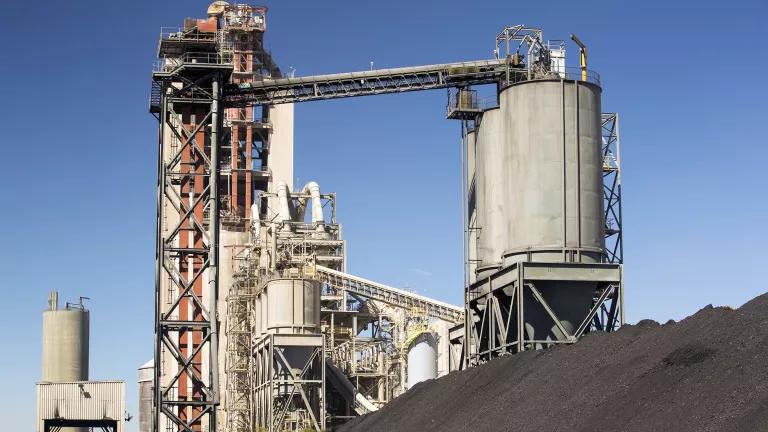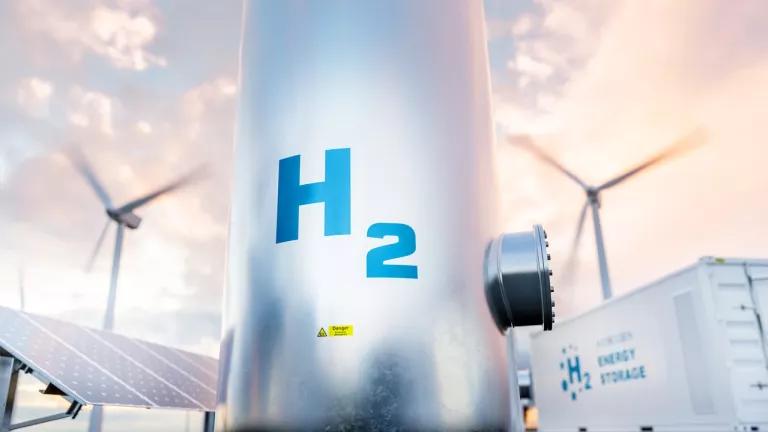DOE Must Use Its Industrial Demonstrations Program Strategically
The U.S. Department of Energy should focus the program’s spending on bold projects.

A cement plant in Tehachapi Pass, California
Ashley Cooper/Getty Images
Heavy industry presents a climate paradox. Industrial materials like cement, steel, and aluminum are foundational for our economy and constitute the building blocks of our clean energy future. At the same time, heavy industry is a significant source of U.S. and global greenhouse gas (GHG) emissions, and without action, the industrial sector will soon become the leading source of domestic GHG emissions.
Fortunately, the Inflation Reduction Act (IRA) and Bipartisan Infrastructure Law (BIL) included game-changing new investments for industrial decarbonization. With application deadlines approaching for some of these funding streams, it is time to focus on the plans and strategies for deploying these funds, driving innovation, and defining our pathway toward industrial decarbonization.
To meet climate targets, we must use new funding from IRA and BIL strategically to simultaneously pursue two separate industrial decarbonization strategies. First, we must rapidly deploy commercially available renewable energy, energy efficiency, and decarbonization technologies across facilities of all sizes. Second, we must support early-stage deployments of advanced, pre-commercial technologies that have the potential to significantly reduce or even eliminate emissions from industrial manufacturing.
Among the IRA and BIL funding, the U.S. Department of Energy (DOE) Office of Clean Energy Demonstration’s (OCED) $6.3 billion Industrial Demonstrations Program is uniquely situated to support early-stage deployments of advanced, pre-commercial technologies. To ensure OCED is making the most of its limited funding, it should focus on high-impact projects in critical sectors like steel, cement, and aluminum, which require advanced technologies to deeply decarbonize.
Industrial decarbonization has much catching up to do and lots of targets to hit, from research and development to energy efficiency and an enhanced ability for industrial users’ ability to access affordable clean energy. The DOE should look at this pot of money and its applicants with an eye toward hitting ambitious targets that may not be reached with private financing and business-as-usual strategies. And given the long horizons for building or retrofitting industrial sites, it is critical that policymakers advance policies now to jump-start investments and plans.
This blog examines some of the emerging technologies that can transform the cement, steel, and aluminum sectors and that should be a focus for funding under the Industrial Demonstrations Program.
Cement/Concrete
Cement is the main ingredient in concrete, the most-used human-generated material on earth. Production of cement is a significant contributor to climate change; if cement were a country, it would be the world’s fourth-largest emitter of CO2 behind China, the United States, and India.
Roughly 60 percent of the emissions from cement production result from the chemical process of calcination, during which limestone is heated to 1,400°C in a kiln. The process releases CO2 from the rock and produces clinker, a stony residue that is ground and combined with other ingredients to make cement. The remaining 40 percent of emissions come from burning fossil fuels to heat the kiln. Near-term solutions to cement’s climate problem exist, like improving plant energy efficiency and partially replacing traditional cement with low-carbon alternatives. However, even in combination, these solutions cannot eliminate emissions from cement production. At least 30 percent of cement’s emissions (often more) will remain unaffected and continue to be emitted into the atmosphere.
Emerging technologies have the potential to become game-changers in the cement sector and result in zero-carbon (or even negative-emission) cement. In particular, OCED should consider the following technologies that have the potential to produce near-zero-carbon cement:
- Carbon capture and storage: Full decarbonization of existing cement plants will require the deployment of carbon capture to abate process emissions resulting from the calcination of limestone. Some captured carbon can be stored in concrete or be permanently sequestered underground. Carbon capture is a well-understood technology and has been deployed in targeted sectors. A pilot cement facility with carbon capture is under development in Europe.
- Alternative cement inputs: Cement today is made using limestone as an input, which releases CO2 when heated. Replacing limestone with alternative inputs that do not contain carbon, such as calcium silicate rock, can eliminate the process emissions associated with traditional cement and produce an identical product with equal performance. Producing cement from calcium silicate rock is newly technically proven, but the technology is still pre-commercial.
- Electrochemical processes: Conventional cement production relies on fossil fuel–fired kilns. Novel, pre-commercial processes like electrochemical calcination use electricity to induce chemical reactions that break down limestone or other calcium-bearing minerals into their constituent parts to produce near-zero-emissions cement without combustion.
Steel
Steel is the most-used metal in the world by mass, and demand for steel is projected to increase from about 1,880 million tonnes in 2020 to as much as 2,500 million tonnes by 2050. At current production levels, steel accounts for roughly 7 to 8 percent of global CO2 emissions.
There are relatively low-emissions processes for recycling steel, and opportunities to increase recycling and effectively decarbonize the electricity used to power recycling processes should be pursued. However, production of “primary steel” from raw iron ore will be necessary to meet total steel demand through 2050. The dominant production method today for primary steel requires burning coke (a fuel derived from coal) to chemically reduce iron ores at temperatures of up to 2,300°C. Decarbonizing the sector will require either replacing coke or otherwise abating emissions from steel, and both of these decarbonization pathways will require deployment of relatively early-stage technologies.
The high emissions intensity of steel coupled with the nascent technologies needed for emissions abatement make primary steel production a particularly compelling target for support under OCED’s Industrial Demonstrations Program.
In particular, OCED should consider three pathways for decarbonization of primary steel production:
- Direct reduction of iron using green hydrogen: Significant reductions in emissions from primary steelmaking can be achieved by replacing the dominant production method that requires coke with a process that runs on 100 percent hydrogen. To the extent that the hydrogen is green—produced from water using renewable electricity—the process would result in nearly emissions-free steel. The use of green hydrogen in steelmaking is a technically proven production method, and all major European steel players have received government support to build or test the technology.
- Molten oxide electrolysis: Molten oxide electrolysis (MOE) replaces fossil fuel–intensive processing in blast furnaces with clean electricity to convert iron ore directly into steel within a modular cell. While the technology is at a pre-commercial stage, the MOE process could be transformative in the steel industry and would eliminate the need for coal in steel production and, therefore, substantially reduce emissions.
- Carbon capture and storage (CCS): Emissions from blast furnace steelmaking can potentially be abated by capturing the CO2 emitted at steel facilities and storing it permanently underground, but this application of CCS faces high technical and economic hurdles, in part because there are many independent point sources of GHGs from steel production.
Aluminum
Aluminum is the second-most-used metal in the world. It is currently responsible for 2 percent of global GHG emissions, and demand for the material—which is critical for the production of clean technologies like electric vehicles, grid infrastructure, and solar PV instillations—is growing significantly. While aluminum recycling is a necessary and low-emissions pathway for reducing emissions from the sector, “primary” aluminum (produced from bauxite, which is refined into alumina and then smelted into aluminum) will be necessary to meet total demand thorough 2050.
Aluminum production is an electricity-intensive process, and most emissions from the sector are related to power generation. Increasing the amount of electricity generated with renewable, zero-carbon resources is a key pathway to decarbonizing aluminum manufacturing, and it should be a focus of DOE through its IRA- and BIL-funded programs.
In addition to these power sector emissions, aluminum production generates substantial process emissions that cannot be mitigated by switching to renewable energy. These process emissions are generated through degradation of carbon-based anodes used in the smelting process. Degradation of these anodes is also a key contributor to local air pollution. OCED’s Industrial Demonstrations Program can help eliminate these process emissions by supporting deployment of inert anodes for primary aluminum production.
- Inert anodes: This pre-commercial technology replaces the carbon anodes used in traditional aluminum smelting with inert anodes, eliminating the direct CO2 emissions from the aluminum smelter and instead emitting pure oxygen. Coupled with a 100 percent clean energy facility, inert anodes have the capacity to produce near-zero-GHG aluminum. There are pilot projects underway elsewhere in the world, and there is a strong case to expand the technology to plants in the United States.
Other federal funding opportunities
Additional measures will be absolutely necessary to reduce emissions from the industrial sector, from research and development to energy efficiency and an enhanced ability for industrial users’ ability to access affordable clean energy. To reach these goals, the DOE should ensure it is using all its tools to their highest and best uses. For instance, the 48C Advanced Manufacturing Tax Credit, which offers a 30 percent tax credit for industrial facilities that reduce emissions by at least 20 percent, may be better suited for widespread, smaller-scale industrial decarbonization technologies across a broad range of industries. Additionally, the Loan Programs Office (LPO) has significant lending authority and can support industrial decarbonization. As such, LPO may be well situated to support large, high-impact industrial decarbonization projects with a slightly higher “technology readiness level” than those OCED can support through its Industrial Demonstrations Program.
Conclusion
As OCED reviews applications for the Industrial Demonstrations Program, we suggest the office keep these other funding tools in mind; use its unique pot of money to support transformative deployments of pre-commercial technologies; and work across DOE and the whole of government to direct applicants with good projects that are not a right fit for the Industrial Demonstrations Program to other opportunities.





